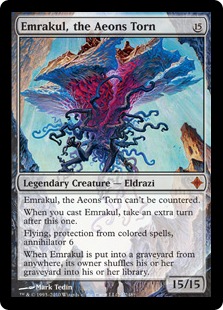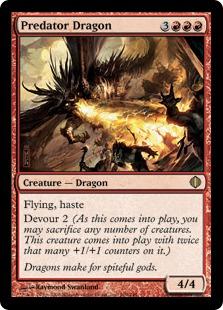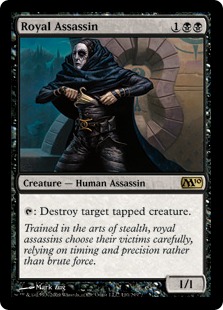
Cranial Insertion
Emrakul can be Oblivion-Ringed
or, Yes, Really!
By Eli Shiffrin, Brian Paskoff, and Carsten Haese
Emrakul can be Oblivion-Ringed
or, Yes, Really!
By Eli Shiffrin, Brian Paskoff, and Carsten Haese
[This article is available in Spanish here.]

And the Emmy goes to...
If you have a question you would like us to answer, please send it to [email]cranial.insertion@gmail.com[/email]. If there is an answer, you'll get one, and your question might be published in a future issue.
Q: Could you explain why Oblivion Ring can send Emrakul, the Aeons Torn into exile, but not, say, a Black Knight?
A: Sure! Protection means four specific things. When a permanent has protection from a quality, let's say for example protection from white, that means the following:
* Damage that white sources would deal to it is prevented.
* White enchantments, equipment, or fortifications can't be attached to it.
* White creatures can't block it if it's an attacking creature.
* White spells and abilities from white sources can't target it.
In Emrakul's case, since it has protection from colored spells only, two of those aspects end up being void, since spells can't be attached to anything, and spells can't block anything. So, this means that:
* Damage that colored spells would deal to Emrakul is prevented, and
* Colored spells and abilities from sources that are colored spells can't target it.
While Oblivion Ring is a colored spell when you cast it, it doesn't actually target anything yet, because non-Aura permanent spells never target anything. Whether Emrakul has protection is irrelevant at that stage, since Oblivion Ring isn't even looking at Emmy yet.
When Oblivion Ring resolves, it enters the battlefield, so its enter-the-battleffield ability triggers. Now you select a target for its ability. Emmy's protection protects it from being targeted by colored spells, but an ability is not a spell. Its protection also protects it from being targeted by abilities from sources that are colored spells, but the source of Oblivion Ring's ability is the Oblivion Ring on the battlefield, which is a permanent, not a spell. Therefore, Emmy's protection has no objection to Emmy being targeted by Oblivion Ring's ability, and Emmy ends up being exiled.
Black Knight on the other hand, has protection not just from white spells, but from anything that is white. When Oblivion Ring's ability tries to target it, protection sees that the source of the ability is white and says, "Access denied!"
Q: I control a Kor Spiritdancer and a Mesa Enchantress, and i cast Ardent Plea. If I cascade into an Aura, do I get to draw two cards?
A: Yes! The Spiritdancer's and Enchantress' abilities trigger off of you casting stuff, and cascade does offer you to cast the card, so both card-drawing abilities are triggered by casting an Aura off of cascade.
Q: How come Iona, Shield of Emeria's spell-forbidding effect ends when she leaves the battlefield, yet her ability doesn't specify a duration like Charisma does?
A: Iona's ability doesn't need to specify a duration because it is a static ability, and continuous effects from static abilities usually function only as long as the object with the ability is on the battlefield. Iona's effect ends as soon as she leaves the battlefield, just like Glorious Anthem stops boosting your creatures when it leaves the battlefield.
Charisma's ability specifies a duration because it is a triggered ability. In contrast to continuous effects from static abilities, continuous effects that are created by resolving spells, activated abilities, and triggered abilities will last indefinitely if they don't specify a duration. The effect that is created by the resolution of Charisma's triggered ability is intended to have a limited duration, so it needs to specify that duration.
Q: If my opponent has 5 cards in his graveyard, can I cast Suffer the Past for an X greater than 5 to make him lose more than 5 life and gain that much life myself?
A: Sadly, no, that doesn't work for two reasons. For one, you need to target X different cards, so X can't be bigger than the number of cards that are in the targeted player's graveyard when you cast Suffer the Past. Secondly, even if X could be bigger, the amount of life loss and life gain is not actually X; it's exactly equal to the number of cards that Suffer the Past managed to exile. This means that you can never make your opponent lose more life than the number of cards that are in his graveyard when Suffer the Past resolves.
Q: I control two Goblin Guides and a Knucklebone Witch and my opponent casts Pyroclasm. Can I put my Goblin Guides into the graveyard first, triggering the Witch's counter ability to let the Witch survive?
A: Nope, your Witch is toast. All creatures that have taken lethal damage from Pyroclasm are destroyed at the same time, so the Witch goes to the graveyard at the same time as the Goblin Guides. You can arrange the cards in the graveyard any way you want, but that doesn't change the fact that the Witch is already in the graveyard and her triggered ability won't be able to save her.

Hot enough for you?
A: Unfortunately, your Predator Dragon will go hungry. Devour is not a triggered ability. It's a replacement effect that changes how Predator Dragon enters the battlefield, so it can only devour creatures that are already on the battlefield at that time. The Thralls won't enter the battlefield until long after Predator Dragon has already looked around for its meal.
Q: Okay, so what happens if the Thralls are already on the battlefield? Can I devour them and then have them pop right back out of the graveyard when Predator Dragon enters the battlefield?
A: Yes, that works! Predator Dragon's resolution is one event in which the Thralls go to the graveyard due to being devoured and Predator Dragon enters the battlefield at the same time. After this event, the game checks for any triggered abilties whose trigger condition matches the event that just happened. The Bladewing's Thrall's ability matches the event, so the ability is triggered even though that event is what put them into the graveyard in the first place.
Q: I control an Island that's enchanted with Wind Zendikon and my opponent casts All is Dust. Do I have to sacrifice only the enchantment or both the enchantment and the Island?
A: You have to sacrifice all your colored permanents simultaneously, and the Island is currently a colored permanent, so it goes into the bin at the same time as the Zendikon. The Zendikon's ability still triggers, though, because it triggers based on the game state immediately prior to you sacrificing your colored permanents, so the Island gets returned to your hand.
Q: If I control multiple Pyromancer Ascensions each with two or more counters on them and I cast Lightning Bolt, does it get copied once for each Pyromancer Ascension?
A: Yes! Each Pyromancer Ascension's ability triggers and resolves separately, so you'll get one copy for each Pyromancer Ascension. Good for you, bad for your opponent!
Q: I have a fully leveled Echo Mage and a Pyromancer Ascension without quest counters on the battlefield and a Lightning Bolt in the graveyard. If I cast another Lightning Bolt, how much damage can I do to my opponent?
A: Looks like 9 damage to me. Pyromancer Ascension's counter-adding ability triggers when you cast a spell. Echo Mage lets you copy a spell, which is not the same as casting a spell, so the copies of Lightning Bolt won't add any more counters to Pyromancer Ascension. Your Lightning Bolt adds one counter to PA and gets copied twice by Echo Mage, for a total of 9 damage.
Q: I control Pyromancer Ascension without any counters and Clockspinning is in my graveyard. Can I cast another Clockspinning to put two counters onto the Ascension?
A: Yes, that works. Clockspinning can target a permanent regardless of whether there are any counters on it. If there are no counters on the permanent when Clockspinning resolves, it simply does nothing. However, in this case a quest counter will be added just in time because Pyromancer Ascension's counter-adding ability goes on the stack above Clockspinning and resolves first so that Clockspinning can then add a second quest counter.
Q: I have heard that abilities on the stack are independent of their source, but I am not sure if you can use Siege-Gang Commander's ability to sacrifice itself and deal the damage. The ability says that Siege-Gang commander deals the damage, but it won't be around to deal the damage when the ability resolves, so no damage will be dealt, right?
A: As unintuitive as it may seem, that actually works. If it didn't, Mogg Fanatic would be a fairly useless card. The reason why it works is spelled out in the very same rule that states that abilities on the stack are independent of their source:
Quote from
Once activated or triggered, an ability exists on the stack independently of its source. Destruction or removal of the source after that time won't affect the ability. Note that some abilities cause a source to do something (for example, "Prodigal Sorcerer deals 1 damage to target creature or player") rather than the ability doing anything directly. In these cases, any activated or triggered ability that references information about the source because the effect needs to be divided checks that information when the ability is put onto the stack. Otherwise, it will check that information when it resolves. In both instances, if the source is no longer in the zone it's expected to be in at that time, its last known information is used. The source can still perform the action even though it no longer exists.
The very last sentence is what allows Siege-Gang Commander--or rather, its last-known-information ghost image--to deal the damage if you sacrificed it to pay for its own ability.

Not even Gideon Jura is safe from him
A: Of course! Gideon Jura becomes a creature without vigilance, so attacking causes him to become tapped. The fact that he's also a planeswalker doesn't change that. Until the end of the turn, he'll be a tapped creature and therefore a legal target for Royal Assassin's ability.
Q: I control Garruk Wildspeaker and my opponent Vindicates him to get rid of him. In response, I cast Reknit to regenerate Garruk. Does Garruk become tapped?
A: Yes, any permanent whose destruction is replaced by regeneration becomes tapped. The game probably won't notice much of a difference between a tapped planeswalker and an untapped planeswalker, but Garruk will be tapped for now.
Q: Let's say I control Scion of the Ur-Dragon and Hellkite Overlord, and my opponent doesn't like getting his face smashed by them so he casts Ixidron to turn them face-down. I know that the rules tell me to distinguish the order in which face-down permanents entered the battlefield, but my two Dragons got turned face-down at the same time, so am I allowed to mix them up so my opponent doesn't know which is which?
A: No, you can't do that. Let's look at the rule:
Quote from
If you control multiple face-down spells or face-down permanents, you must ensure at all times that your face-down spells and permanents can be easily differentiated from each other. This includes, but is not limited to, knowing the order spells were cast, the order that face-down permanents entered the battlefield, which creature attacked last turn, and any other differences between face-down spells or permanents. Common methods for distinguishing between face-down objects include using counters or dice to mark the different objects, or clearly placing those objects in order on the table.
According to this rule, any information that distinguishes the two face-down permanents must be preserved. That includes the information about which one was the Scion and which one was the Overlord.
Q: I control Psychogenic Probe and my opponent casts the last card in his hand, a Whirlpool Rider. Does he still have to shuffle his library and trigger the Probe when Whirlpool Rider's enter-the-battlefield ability resolves?
A: Yup, he'll get probed! When a player shuffles a set of non-specific objects into his library, he has to shuffle his library even if the set is empty.
Q: Lion's Eye Diamond must be the most confusing card ever. I just don't get it! Can I cast a spell from my hand with its mana? If not, what can I do with it?
A: Lion's Eye Diamond is confusing because you want it to be more powerful than it is. The sad truth is that it's almost impossible to use the mana from LED to cast something that's in your hand. The reason for that is that you have to throw away your hand in order to get the mana, and after you do that, you don't have anything in your hand to cast with that mana. And, as Brian has explained in his recent episode, you can't announce the spell and then crack the diamond during the spell announcement window because of the timing restriction on LED's ability. It's a conundrum!
The only way you can cast something from your hand with LED's mana is if you get that card into your hand after you've cracked the diamond. One way to do that is to cast a card-drawing or tutoring spell with some other mana, and respond to that spell by cracking the diamond. You get the mana from the diamond, and then you get a card into your hand that you can cast with the mana from the diamond. This works well with Infernal Tutor because the "discard your hand" cost ensures that you're hellbent when Infernal Tutor resolves.
Of course, casting spells from your hand isn't the only thing you can do with mana. With some help such as retrace, flashback, or Yawgmoth's Will, it's possible to cast spells from your graveyard, and there are other effects that allow you to cast spells from other zones, too. Imagine using the mana from LED to cast a spell from your opponent's hand with Sen Triplets! Or, you could do something really obvious and just use the mana to pay for an activated ability, such as activating Pestilence three times. Once you abandon the idea of casting a spell from your hand, you'll find lots of other uses for Lion's Eye Diamond.
Q: I'm building an EDH deck with Experiment Kraj as my general, and I want to know if Callous Oppressor would work in this deck. If Kraj copies the Oppressor's ability, what exactly happens when I activate the ability?
A: Not much of anything will happen. In fact, you won't even be able to activate the ability. The problem is that no creature type was chosen for Kraj's instance of the gain-control ability, so the creature type is undefined, and rule 706.7a tells us what happens in that case:
Quote from
If an ability refers to an undefined choice, that part of the ability won't do anything.
In this case, the part that refers to the undefined choice is the targeting description, and it's bad if that doesn't do anything, because that means that the game doesn't know what a legal target for the ability is. No matter which target you'd pick, the game wouldn't believe you that it's a legal target, so you can't activate the ability.
Q: Where I play Friday Night Magic, we consistently have over 16 players, but there are always 4 rounds with a cut to the top 4 regardless of how many players are present. Someone from out of town told me that if there are 16 or more players present, there must be a top 8. Is he right?
A: No. There are some events for which Wizards of the Coast requires certain round structures, such as Grand Prix Trials and Pro Tour Qualifiers, but there is no such requirement for Friday Night Magic. The only requirement is that the tournament have at least 3 rounds, which is the minimum requirement for any DCI sanctioned tournament with individual players. Beyond that, it's up to the tournament organizer's discretion. It's certainly possible that the out-of-towner's TO does a cut to top 8 for sufficiently large attendance, but that's not a requirement. In theory, a TO could run a 256 player FNM in just three Swiss rounds and call it a night.
Speaking of calling it a night, this seems like a good place to stop. Thanks for reading, and please come back next week when we check in with Brian to see whether he has managed to regain his proper place in the space-time-continuum.
- Carsten Haese
Comments